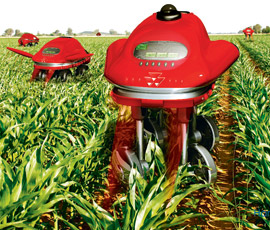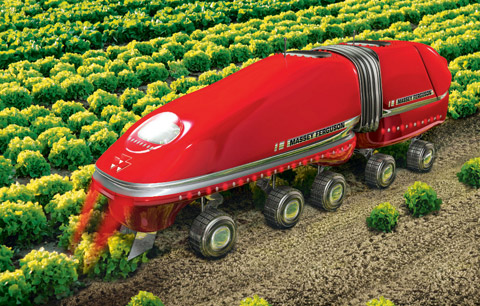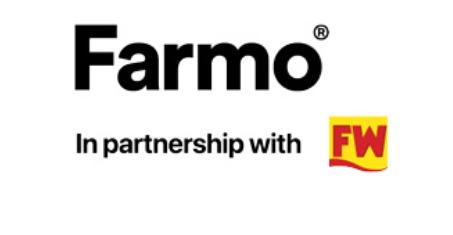Think smart and small for the future of crop protection

Imagine armies of small robots navigating through fields carrying out micro-cultivations, positioning a seed precisely and managing the crop in a state-of-the-art manner. According to Simon Blackmore, an agricultural engineer at Harper Adams University College, this technology is so close we can almost touch it.
“In every case – economics, environmental, efficiency, benefit to society and reliability – I see no reason why robots can’t be adopted now.”
He believes that within 10 years robots will fit into existing cropping regimes by using the same agronomy, variety and chemical inputs, but using small, affordable, very smart machines to carry out the in-field operations.
Prof Blackmore is involved in the design of a series of prototype machines that make up a complete mechanisation system, one component being the Scamp Scout.
“The concept of the Scout is that it has a range of non-contact solid-state sensing systems in it, including machine-vision, laser scanners to measure the growth, height and canopy density. Hyper and multi-spectral cameras that can measure non-visible wavelength can tell us about the nutrient status and crop growth stage and warn us when it is under pest disease or attack. We can have biosensors that can measure ethylene production and a whole lot of other crop growth parameters.
“The Scout won’t replace a person, but it will enhance the role of an agronomist because the robot can cover a greater area, take measurements and when it finds a certain characteristic of interest, it can alert the agronomist to come and have a look,” he explains.
Crop care in terms of robotic crop scouting could mean savings of up to 99.9% in herbicide costs through spot treatment of the weed only. This highlights the essence of precision farming, where yield increases are not the main driver, rather reducing the cost of production and controlling quality, he says.
Prof Blackmore sees the high-value, more labour-intensive row crops benefiting from the technology before combinable crops, because initially robots will be slow and small and they won’t be able to cope with very high work rates such as harvesting large areas of potatoes or wheat. “It is a niche, a partnership between the small machines and the big machines,” he says.
In future it won’t just be the machines getting smaller, agricultural inputs will be greatly impacted by another very promising area of science – nanotechnology.
This is the science, engineering and technology conducted at the nanoscale which is 1-100nm (1nm being a billionth of a metre). Materials behave differently at the nanoscale and it is this aspect that lends itself to benefit the industry in many ways.
Reformulation of existing active ingredients using nanotechnology, smart delivery systems such as nanoencapsulation and biosensors are some examples that will benefit the industry tremendously, according to David Carlander, director of advocacy at the Nanotechnology Industries Association.

It is the reformulation work that Dr Carlander believes will happen first, with modifications to the active ingredients giving rise to products with improved qualities such as reduced drift, masking of odour, improved uptake and residual activity. “Most are still in development, although reformulation is a continuous process for product development and market introductions.”
Andrew Elphick of IOTA NanoSolutions, a company in Liverpool working on nanoemulsions with three major agrochemical companies, says: “Nanotechnology doesn’t change the chemistry, but gives more even deposition on surfaces and better uptake and resistance to wash off. We also have approaches to protect from UV degradation.”
These new formulations offer improved efficacy, allowing for either reduced rates or superior control at existing rates. There is also the opportunity to overcome incompatibilities by building combination particles that contain more than one active, he explains.
Precise and targeted pesticide delivery through nanoencapsulation, creating a small particle and protecting it from the environment until it gets to where it is supposed to be, will allow release of active ingredients sustained over an extended period of time or in a controlled manner either triggered by changes in pH, temperature or moisture. This technique can impact reduction on non-target organisms.
Growers might also see the introduction of in-field or systemic biosensors to give real-time monitoring of soil conditions and crop growth, which could be used to identify plant health issues before these become visible to the farmer.
But, growers need not worry that this sophisticated technology will cost more than current practice, according to Dr Carlander. “Nanotechnology is following traditional technology market entrance patterns. As demand increases, the cost of supplying will be reduced as a consequence of economies of scale.”

